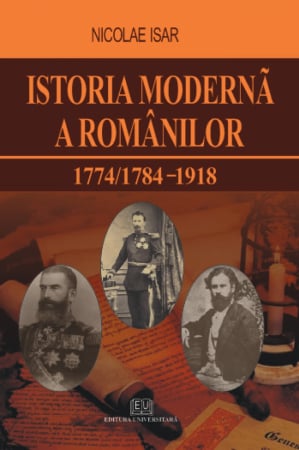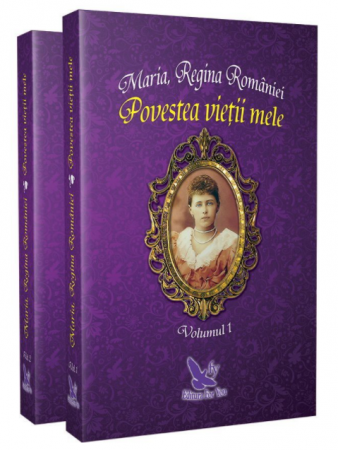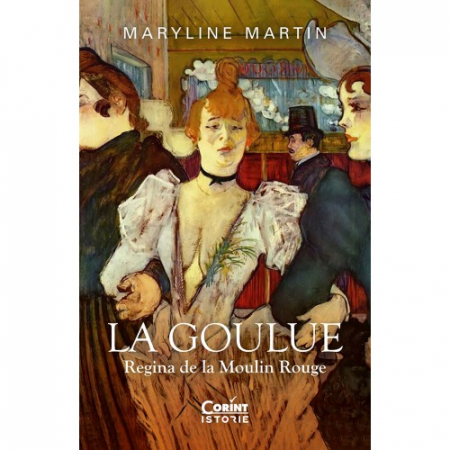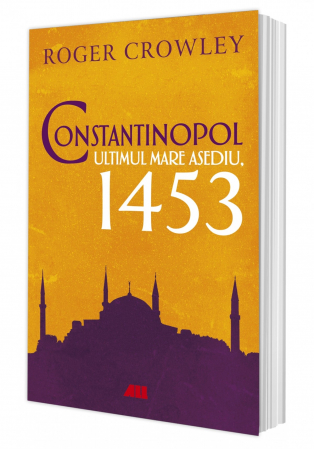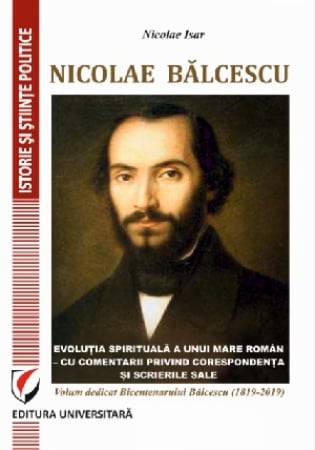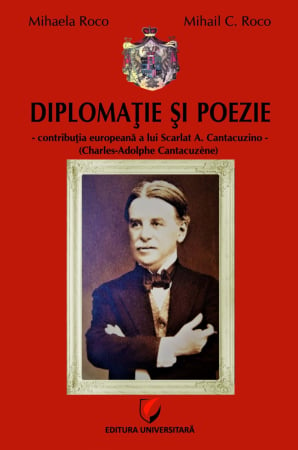Manuscript proposals: [email protected] / 0745 204 115 //// Tracking orders Individuals / Sales: 0745 200 357 / Orders Legal entities: 0721 722 783
ISBN: 978-606-28-0949-2
DOI: 10.5682/9786062809492
Publisher year: 2019
Edition: I
Pages: 258
Publisher: Editura Universitară
Author: Nicolae Isar
Product Code:
9786062809492
Do you need help?
0745 200 357
- Authors
- Content
- More details
- Reviews (0)
Preface / 5
I. Gheorghe Lazar and his school in the vision of Nicolae Iorga / 13
II. Tudor Vladimirescu in the vision of Nicolae Iorga / 39
III. Nicolae Balcescu in the vision of Nicolae Iorga / 63
IV. Nicolae Iorga in defense of the memory of Prince Alexandru I. Cuza / 116
V. The personality of Mihail Kogalniceanu in the evocations of Nicolae Iorga / 158
ANNEXES
I. From the writings of Nicolae Iorga dedicated to Gheorghe Lazar / 189
1. Preface to the volume, The first teacher of national ideal, Gheorghe Lazar (1916) / 189
2. Speech on the occasion of the commemoration of Dimitrie Cantemir and Gheorghe Lazar (1923) / 191
II. From the writings of Nicolae Iorga dedicated to Tudor Vladimirescu / 198
1. Preface to the volume, A Defender of the Poor. "Mr. Tudor of Vladimir" (ca. 1750-1821),
Bucharest, 1921 (second edition) / 198
2. The retreat, capture and death of Tudor (End of the work, A defender of the poor) / 201
3. Commemoration of Tudor Vladimirescu, Speech in the meeting of the Romanian Academy of June 5, 1921/204
4. The commemoration of "Mr. Tudor" (1921) / 213
5. Mr. Tudor (1921) / 214
III. From the writings of Nicolae Iorga dedicated to Nicolae Balcescu / 216
- Preface to the study, Neculai Balcescu [1891] / 216
IV. From the writings of Nicolae Iorga dedicated to the ruler Al. I. Cuza / 219
- The lessons from the life and reign of Cuza-Voda (Conference held in Husi, 1909) / 219
V. From the evocations of Nicolae Iorga regarding the work and personality of Mihail Kogalniceanu / 229
1. The great speeches of M. Kogalniceanu [1905] / 229
2. Cuza-Voda and Kogalniceanu - An outing of Cuza-Voda - / 230
3. Cuza and Kogalniceanu. Ideas from a conference held in Braila on January 24, 1910/233
4. Speech at the inauguration of the statue of Mihail Kogalniceanu [4 Oct. 1911] / 243
5. Nicolae Iorga, O comemorare (18 oct. 1918) / 245
6. The personality of Mihail Kogalniceanu [February 2, 1935] / 246
I. Gheorghe Lazar and his school in the vision of Nicolae Iorga / 13
II. Tudor Vladimirescu in the vision of Nicolae Iorga / 39
III. Nicolae Balcescu in the vision of Nicolae Iorga / 63
IV. Nicolae Iorga in defense of the memory of Prince Alexandru I. Cuza / 116
V. The personality of Mihail Kogalniceanu in the evocations of Nicolae Iorga / 158
ANNEXES
I. From the writings of Nicolae Iorga dedicated to Gheorghe Lazar / 189
1. Preface to the volume, The first teacher of national ideal, Gheorghe Lazar (1916) / 189
2. Speech on the occasion of the commemoration of Dimitrie Cantemir and Gheorghe Lazar (1923) / 191
II. From the writings of Nicolae Iorga dedicated to Tudor Vladimirescu / 198
1. Preface to the volume, A Defender of the Poor. "Mr. Tudor of Vladimir" (ca. 1750-1821),
Bucharest, 1921 (second edition) / 198
2. The retreat, capture and death of Tudor (End of the work, A defender of the poor) / 201
3. Commemoration of Tudor Vladimirescu, Speech in the meeting of the Romanian Academy of June 5, 1921/204
4. The commemoration of "Mr. Tudor" (1921) / 213
5. Mr. Tudor (1921) / 214
III. From the writings of Nicolae Iorga dedicated to Nicolae Balcescu / 216
- Preface to the study, Neculai Balcescu [1891] / 216
IV. From the writings of Nicolae Iorga dedicated to the ruler Al. I. Cuza / 219
- The lessons from the life and reign of Cuza-Voda (Conference held in Husi, 1909) / 219
V. From the evocations of Nicolae Iorga regarding the work and personality of Mihail Kogalniceanu / 229
1. The great speeches of M. Kogalniceanu [1905] / 229
2. Cuza-Voda and Kogalniceanu - An outing of Cuza-Voda - / 230
3. Cuza and Kogalniceanu. Ideas from a conference held in Braila on January 24, 1910/233
4. Speech at the inauguration of the statue of Mihail Kogalniceanu [4 Oct. 1911] / 243
5. Nicolae Iorga, O comemorare (18 oct. 1918) / 245
6. The personality of Mihail Kogalniceanu [February 2, 1935] / 246
Nicolae Iorga, the great historian, scholar and socio-political thinker - one of the leading scientists that the Romanian people gave to the world in the modern era - has been, over time, and remains a true beacon for deciphering the mysteries. the past of the nation, as well as for the hierarchy of its values.
It can be said, with certainty, that none of the Romanian scholars did so much for this placement of the great personalities on a value scale meant to keep their memory alive in the eyes of contemporaries. The option for defining the character and merits of the representative figures of the Romanian people was stated by the scientist, among others, in a book, significantly entitled, People who have been, appeared over time in numerous editions, to this day.
Also, the biographies made of different figures, in separate works, but also in the pages of his great syntheses and numerous monographs, speak for themselves of this exceptional vocation of the scientist to capture the details of material and spiritual life of illustrious figures of the past.
Of course, the notion of "great Romanians", trivialized lately through public competitions with this subject, is quite relative, as any value scale has a certain degree of rigidity. There are, however, a number of elements that can justify it, such as: the major contribution to the defense of the national being and the spirit of sacrifice on the altar of national aspirations and social progress, the contribution to affirming the vein of national culture and enriching the treasure of culture. universal, responsible employment in the field of irradiating the ideas of national freedom and social justice, etc. and so on.
Unquestionably, in terms of undeniable historical merits, in the category of exceptional personalities, who well deserve the title of great Romanians, Nicolae Iorga places the well-known rulers, protagonists of the struggle for the defense of independence and national sovereignty: Mircea cel Batran, Iancu de Hunedoara, Stefan cel Mare, Mihai Viteazul, Constantin Brancoveanu, Dimitrie Cantemir and In the same series, but, first of all, as rulers of spiritual and cultural values are placed some rulers, such as Neagoe Basarab, Matei Basarab or Serban Cantacuzino. As for the merits of Dimitrie Cantemir, as ruler, follower of the "attempt" of 1711, liberation from Ottoman rule, they are amplified by his exceptional qualities as a European scientist, which N. Iorga fully recognizes ( on his personality, as we will see later, N. Iorga returns on the occasion of a commemoration, which was connected with a similar ceremony intended for Gheorghe Lazar).
Also, the political and cultural personalities of the modern era have been in the attention of the great Romanian historian, and in the restricted pages of this book we will only refer to some of the they are, in fact, representative figures for two generations, from 1821 to 1848.
For the generation of 1821, we stopped at two openers - the most important - of the national revival movement in the modern era, one with the pen, Gheorghe Lazar, another, with sword, Tudor Vladimirescu.
It is significant that a former student and successor of Gh. Lazar, at the same time, secretary of Tudor Vladimirescu, in 1821, Petrache Poenaru, over half a century, in 1871, with on the occasion of a reception speech at the Romanian Academy, referring to the two, he wanted to emphasize: "The exclamation made in front of the world, on the one hand, G. Lazar, by releasing the Romanian speech from the numbness to which he was condemned for centuries, on the other hand, Tudor Vladimirescu, through his vigor with his arm of national sense, was the most convincing process that ensured the Romanian people the right to a fortress in the circle of European nations and put them on the path of progress towards the development of their nationality ”.
For the generation from 1848, we also stopped at the figures that, at least for us, seemed to us the most representative for this generation: Nicolae Balcescu, Alexandru I. Cuza and Mihail Kogalniceanu. These are personalities, which, as we will see, as in the cases of Gh. Lazar and Tudor Vladimirescu, in a way, are linked to each other by certain features of destiny.
In fact, if we refer to characteristics that define the quality of "great Romanians", it should be noted here that all five mentioned, which we stopped, have a number of common features in their destiny, standing under the sign of drama. Gheorghe Lazar dies at only 41 years old, in his native Avrigul, after a patriotic struggle for several years, in Bucharest, where he managed to put into operation the national school from Sf. Sava and to put in light, for the benefit of contemporaries, his holy belief in the national ideal.
As for Tudor Vladimirescu, after the 1821 attempt - doomed to failure - to open a new page in Roman history at the age of 41, he ended up assassinated under the yachts of his enemies, thus giving the ultimate sacrifice for a cause that it would only be better understood in a few decades.
In their turn, the three from 1848, to which we refer, are in the same sign of some lives sacrificed on the altar of national interest.
Nicolae Balcescu, the emblematic figure of this generation - whose memory is sometimes unjustly minimized in recent times - after a short life, dedicated, body and soul, revealing the aspirations of national unity, the fundamental coordinates of the struggle for national freedom and social progress - in the middle of the 19th century - he would die on foreign land, in exile, at only 33 years old, giving the example of the future sacrifice supreme for the destiny of his people.
The ruler of the Union, Alexandru I. Cuza, belonged to the same illustrious generation of Pasoptists, who was given, in a reign of only seven years, to carry out the fundamental reforms for consolidating the Union and to open the way for the modernization of Romania. He was also given, after his removal, by a reprehensible conspiracy, to live the last years of his life, in exile, and he died, in precarious conditions, on foreign land, at an age not exactly advanced, 53 years.
Finally, the third of the group of Pasoptist leaders, to which we refer, Mihail Kogalniceanu, the collaborator and advisor of the ruler Al. I. Cuza, in carrying out the great reforms - the most important things that were done during the twentieth century, as N. Iorga would remark -, unlike the others, he will live to old age, over 70 years, but, after the forced abdication of Al. I. Cuza, in February 1866, will live, to a large extent, marginalized among the politicians of the time, ostracized, in a way by the political elites, in the memory of his collaboration with the Prince of the Union, although, by his political and cultural merits, Normally, he was far above many contemporary leaders of public life.
If we refer to N. Iorga's vision of representative figures from the modern era, we must keep in mind that, in many situations, behavioral plans focus not only on qualities or merits, but also on some negative, debatable sides, in any case. An I. Heliade Radulescu, for example, is placed by Nicolae Iorga on a well-deserved pedestal, as the founder of national literature, but will not be recognized by the scientist, rightly, as a leader in the revolution of 1848 and by doctrinaire of it, as sinuosities and inconsistencies in the biographical route diminish his personality in the eyes of the great historian.
Equally demanding will be the scientist referring to various other Pasoptist personalities, viewed under multiple behavioral aspects and in relation to their activity or ideology, put or not in the service of the political and social aspirations of the time. If, for example, about the liberal leaders from 1848, CA Rosetti and IC Bratianu, in the perspective of their future political career, the scientist's opinions remain controversial, not to mention the "president" of the provisional government of Tara Romaneasca from 1848, Metropolitan Neofit , which he makes cowardly and treacherous, instead, the opinions of the scientist, among the leaders from 1848, place Nicolae Balcescu at the head of any value ladder.
Significant are the appreciations of Nicolae Iorga for a series of leaders of the "Transylvanian Romanian Revolution" of 1848-1849, such as Avram Iancu - and he paying with the sacrifice of life, as a young man, the deceived hopes of his fellows -, Simion Barnutiu, Andrei Saguna , but on them, in the confined space of this book, we could not stop.
Obviously, the series of those who would deserve the title of "great novel", in the vision of Nicolae Iorga, is continued by other representative figures of public and cultural life in the last decades of 19th century and the beginning of the 20th century, to limit ourselves to the chronological framework of the modern era, namely: Bogdan Petriceicu Hasdeu, Vasile Alecsandri, Titu Maiorescu, the painter Nicolae Grigorescu, but especially the national poet and genius publicist , Mihail Eminescu. And to them, as well as to others, the greatest of the great, politicians, writers or scholars, Nicolae Iorga made immortal portraits of them, marking their posthumous glory, drawing from their life and work parables for contemporaries.
Perhaps time will allow us, in the future, to include in a second volume the last personalities, mentioned here, completing the suite of "great Romanians" who marked the evolution of Romania throughout the modern era, and on which the pen stopped. the great Romanian historian. Until such a happy eventuality, this volume, dedicated to the important representatives of the generations from 1821 and 1848 - historical events that entered especially in our preoccupations -, we hope to offer first of all, Nicolae Iorga's vision on these personalities, to offer the opportunity of a confrontation with the own opinions of the readers, lovers of national history, being well known the fact that almost everything that comes from the pen of the scientist cannot leave us indifferent, everything - or almost everything - suggests models and parables of life, whose memory we can't do without it.
Let us mention here, concluding this preface, that in the final part of the volume, we have attached a series of significant texts belonging to Nicolae Iorga, illustrating the analysis of these remarkable personalities. The author
It can be said, with certainty, that none of the Romanian scholars did so much for this placement of the great personalities on a value scale meant to keep their memory alive in the eyes of contemporaries. The option for defining the character and merits of the representative figures of the Romanian people was stated by the scientist, among others, in a book, significantly entitled, People who have been, appeared over time in numerous editions, to this day.
Also, the biographies made of different figures, in separate works, but also in the pages of his great syntheses and numerous monographs, speak for themselves of this exceptional vocation of the scientist to capture the details of material and spiritual life of illustrious figures of the past.
Of course, the notion of "great Romanians", trivialized lately through public competitions with this subject, is quite relative, as any value scale has a certain degree of rigidity. There are, however, a number of elements that can justify it, such as: the major contribution to the defense of the national being and the spirit of sacrifice on the altar of national aspirations and social progress, the contribution to affirming the vein of national culture and enriching the treasure of culture. universal, responsible employment in the field of irradiating the ideas of national freedom and social justice, etc. and so on.
Unquestionably, in terms of undeniable historical merits, in the category of exceptional personalities, who well deserve the title of great Romanians, Nicolae Iorga places the well-known rulers, protagonists of the struggle for the defense of independence and national sovereignty: Mircea cel Batran, Iancu de Hunedoara, Stefan cel Mare, Mihai Viteazul, Constantin Brancoveanu, Dimitrie Cantemir and In the same series, but, first of all, as rulers of spiritual and cultural values are placed some rulers, such as Neagoe Basarab, Matei Basarab or Serban Cantacuzino. As for the merits of Dimitrie Cantemir, as ruler, follower of the "attempt" of 1711, liberation from Ottoman rule, they are amplified by his exceptional qualities as a European scientist, which N. Iorga fully recognizes ( on his personality, as we will see later, N. Iorga returns on the occasion of a commemoration, which was connected with a similar ceremony intended for Gheorghe Lazar).
Also, the political and cultural personalities of the modern era have been in the attention of the great Romanian historian, and in the restricted pages of this book we will only refer to some of the they are, in fact, representative figures for two generations, from 1821 to 1848.
For the generation of 1821, we stopped at two openers - the most important - of the national revival movement in the modern era, one with the pen, Gheorghe Lazar, another, with sword, Tudor Vladimirescu.
It is significant that a former student and successor of Gh. Lazar, at the same time, secretary of Tudor Vladimirescu, in 1821, Petrache Poenaru, over half a century, in 1871, with on the occasion of a reception speech at the Romanian Academy, referring to the two, he wanted to emphasize: "The exclamation made in front of the world, on the one hand, G. Lazar, by releasing the Romanian speech from the numbness to which he was condemned for centuries, on the other hand, Tudor Vladimirescu, through his vigor with his arm of national sense, was the most convincing process that ensured the Romanian people the right to a fortress in the circle of European nations and put them on the path of progress towards the development of their nationality ”.
For the generation from 1848, we also stopped at the figures that, at least for us, seemed to us the most representative for this generation: Nicolae Balcescu, Alexandru I. Cuza and Mihail Kogalniceanu. These are personalities, which, as we will see, as in the cases of Gh. Lazar and Tudor Vladimirescu, in a way, are linked to each other by certain features of destiny.
In fact, if we refer to characteristics that define the quality of "great Romanians", it should be noted here that all five mentioned, which we stopped, have a number of common features in their destiny, standing under the sign of drama. Gheorghe Lazar dies at only 41 years old, in his native Avrigul, after a patriotic struggle for several years, in Bucharest, where he managed to put into operation the national school from Sf. Sava and to put in light, for the benefit of contemporaries, his holy belief in the national ideal.
As for Tudor Vladimirescu, after the 1821 attempt - doomed to failure - to open a new page in Roman history at the age of 41, he ended up assassinated under the yachts of his enemies, thus giving the ultimate sacrifice for a cause that it would only be better understood in a few decades.
In their turn, the three from 1848, to which we refer, are in the same sign of some lives sacrificed on the altar of national interest.
Nicolae Balcescu, the emblematic figure of this generation - whose memory is sometimes unjustly minimized in recent times - after a short life, dedicated, body and soul, revealing the aspirations of national unity, the fundamental coordinates of the struggle for national freedom and social progress - in the middle of the 19th century - he would die on foreign land, in exile, at only 33 years old, giving the example of the future sacrifice supreme for the destiny of his people.
The ruler of the Union, Alexandru I. Cuza, belonged to the same illustrious generation of Pasoptists, who was given, in a reign of only seven years, to carry out the fundamental reforms for consolidating the Union and to open the way for the modernization of Romania. He was also given, after his removal, by a reprehensible conspiracy, to live the last years of his life, in exile, and he died, in precarious conditions, on foreign land, at an age not exactly advanced, 53 years.
Finally, the third of the group of Pasoptist leaders, to which we refer, Mihail Kogalniceanu, the collaborator and advisor of the ruler Al. I. Cuza, in carrying out the great reforms - the most important things that were done during the twentieth century, as N. Iorga would remark -, unlike the others, he will live to old age, over 70 years, but, after the forced abdication of Al. I. Cuza, in February 1866, will live, to a large extent, marginalized among the politicians of the time, ostracized, in a way by the political elites, in the memory of his collaboration with the Prince of the Union, although, by his political and cultural merits, Normally, he was far above many contemporary leaders of public life.
If we refer to N. Iorga's vision of representative figures from the modern era, we must keep in mind that, in many situations, behavioral plans focus not only on qualities or merits, but also on some negative, debatable sides, in any case. An I. Heliade Radulescu, for example, is placed by Nicolae Iorga on a well-deserved pedestal, as the founder of national literature, but will not be recognized by the scientist, rightly, as a leader in the revolution of 1848 and by doctrinaire of it, as sinuosities and inconsistencies in the biographical route diminish his personality in the eyes of the great historian.
Equally demanding will be the scientist referring to various other Pasoptist personalities, viewed under multiple behavioral aspects and in relation to their activity or ideology, put or not in the service of the political and social aspirations of the time. If, for example, about the liberal leaders from 1848, CA Rosetti and IC Bratianu, in the perspective of their future political career, the scientist's opinions remain controversial, not to mention the "president" of the provisional government of Tara Romaneasca from 1848, Metropolitan Neofit , which he makes cowardly and treacherous, instead, the opinions of the scientist, among the leaders from 1848, place Nicolae Balcescu at the head of any value ladder.
Significant are the appreciations of Nicolae Iorga for a series of leaders of the "Transylvanian Romanian Revolution" of 1848-1849, such as Avram Iancu - and he paying with the sacrifice of life, as a young man, the deceived hopes of his fellows -, Simion Barnutiu, Andrei Saguna , but on them, in the confined space of this book, we could not stop.
Obviously, the series of those who would deserve the title of "great novel", in the vision of Nicolae Iorga, is continued by other representative figures of public and cultural life in the last decades of 19th century and the beginning of the 20th century, to limit ourselves to the chronological framework of the modern era, namely: Bogdan Petriceicu Hasdeu, Vasile Alecsandri, Titu Maiorescu, the painter Nicolae Grigorescu, but especially the national poet and genius publicist , Mihail Eminescu. And to them, as well as to others, the greatest of the great, politicians, writers or scholars, Nicolae Iorga made immortal portraits of them, marking their posthumous glory, drawing from their life and work parables for contemporaries.
Perhaps time will allow us, in the future, to include in a second volume the last personalities, mentioned here, completing the suite of "great Romanians" who marked the evolution of Romania throughout the modern era, and on which the pen stopped. the great Romanian historian. Until such a happy eventuality, this volume, dedicated to the important representatives of the generations from 1821 and 1848 - historical events that entered especially in our preoccupations -, we hope to offer first of all, Nicolae Iorga's vision on these personalities, to offer the opportunity of a confrontation with the own opinions of the readers, lovers of national history, being well known the fact that almost everything that comes from the pen of the scientist cannot leave us indifferent, everything - or almost everything - suggests models and parables of life, whose memory we can't do without it.
Let us mention here, concluding this preface, that in the final part of the volume, we have attached a series of significant texts belonging to Nicolae Iorga, illustrating the analysis of these remarkable personalities. The author
If you want to express your opinion about this product you can add a review.
write a review

6359.png)
![Notable personalities in the vision of Nicolae Iorga. From Gheorghe Lazar to Mihail Kogalniceanu [1] Notable personalities in the vision of Nicolae Iorga. From Gheorghe Lazar to Mihail Kogalniceanu [1]](https://gomagcdn.ro/domains/editurauniversitara.ro/files/product/large/personalitati-de-seama-in-viziunea-lui-nicolae-iorga-de-la-gheorghe-lazar-la-mihail-kogalniceanu-129-265634.jpg)

